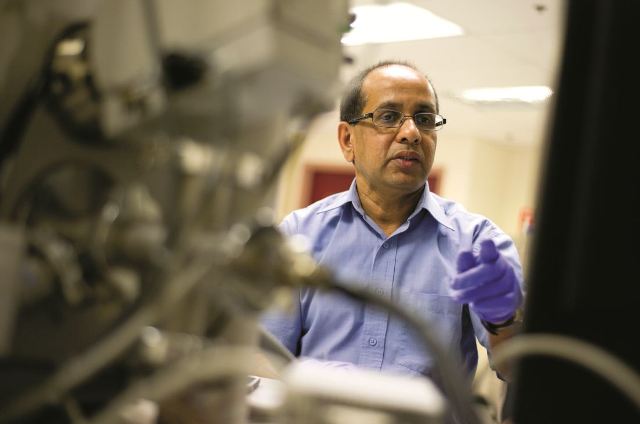Feb 24 2016
Modern-day wheelchairs provide a full range of mobility solutions to those who cannot walk, but many users still battle an unwanted side effect: painful ulcers caused by sitting for long periods in the same position.
 Muthu Wijesundara, UTA Research Institute's principal research scientist, is working with researchers at the University of Pittsburgh to develop a smart seat cushion that will relieve painful pressure ulcers for wheelchair users.
Muthu Wijesundara, UTA Research Institute's principal research scientist, is working with researchers at the University of Pittsburgh to develop a smart seat cushion that will relieve painful pressure ulcers for wheelchair users.
Researchers from The University of Texas at Arlington Research Institute and Human Engineering Research Laboratories at the University of Pittsburgh are developing a solution in an automated seat cushion designed to prevent pressure ulcers in wheelchair users.
The $740,000 project, funded through the Congressionally Directed Medical Research Program Department of Defense and awarded by the U.S. Army Medical Research Acquisition Activity is focused specifically on relief for wheelchair users whose impairments were caused by spinal cord injuries or other neurological complications.
UTARI’s Biomedical Technology Division, led by principal research scientist Muthu Wijesundara, will work with HERL Director Rory A. Cooper to develop the smart seat cushion technology.
“This type of active monitoring and pressure relief would improve pressure ulcer prevention strategies and reduce the workload of caregivers,” Wijesundara said. “Most importantly, this method would impact both the healthcare cost and quality of life for wheelchair users and their caregivers.”
Cooper is a world-renowned expert in smart sensors, wheeled mobility and assistive devices for mobility impairment. He is also co-director of the National Science Foundation’s Quality of Life Technology Engineering Research Center, a joint effort between the University of Pittsburgh and Carnegie Mellon University.
“The research and development of the smart seat cushion would be beneficial to all people with mobility impairment,” Cooper said. “The less someone has to worry about the pain of ulcers, along with expensive and inadequate treatments, the sooner they can focus on other aspects of getting on with their lives and pursuing their ambitions.”
The project is representative of research excellence that is advancing UTA’s commitment to improve health and the human condition under the University’s Strategic Plan 2020: Bold Solutions | Global Impact.
The act of sitting in a wheelchair can have unhealthy implications for people with limited mobility. Mechanical loading forces cause compression and shearing in tissues near bony regions such as the tailbone. If these loading forces are not relieved, blood flow is dramatically reduced and tissues begin to die. These lesions – known as pressure ulcers – can result in tissue loss, bone infection or sepsis.
Once pressure ulcers form, they are notoriously difficult, costly and time consuming to treat. A serious pressure ulcer requires months of treatment with costs running into the hundreds of thousands of dollars, according to the Journal of Wound Care.
Smart seat cushion technology will include real-time pressure monitoring and automated pressure modulation capabilities to help combat the formation and prevalence of pressure ulcers.
A network of sensors will generate a pressure profile map and identify vulnerable areas where pressure relief is needed. Automated pressure modulation will use this data to reconfigure the seat cushion surface to offload pressure from sensitive areas. Additionally, the seat cushion can periodically change the pressure profile to eliminate pressure buildup over time.
UTARI Executive Director Mickey McCabe said the smart cushion project is a wonderful example of UTARI’s drive to develop technologies that can be commercialized in order to improve a person’s quality of life.
“In this case, we’re helping the users of wheelchairs to overcome an uncomfortable and even life-threatening side effect of mobility impairment,” McCabe said. “This grant brings us one step closer to developing a device that will ultimately improve health and the human condition for the benefit of society.”
This work was supported by the Office of the Assistant Secretary of Defense for Health Affairs through the Spinal Cord Injury Research Program under Award No. W81XWH-15-1-0719. Opinions, interpretations, conclusions and recommendations are those of the author and are not necessarily endorsed by the Department of Defense.
UT Arlington Research Institute
The mission of The University of Texas at Arlington Research Institute is to bridge the gap between academic research and product development in the areas of product engineering, biomedical technologies and robotics. UTARI researchers collaborate with partners representing government, industry and higher education. UTARI serves as host of industry symposia, consortia and events that bring partners together to further research and development. Visit www.uta.edu/utari/about/index.php to learn more.
About The University of Texas at Arlington
The University of Texas at Arlington is a Carnegie “highest research activity” institution of more than 50,000 students in campus-based and online degree programs and is the second-largest institution in The University of Texas System. The Chronicle of Higher Education ranked UTA as one of the 20 fastest-growing public research universities in the nation in 2014. U.S. News & World Report ranks UTA fifth in the nation for undergraduate diversity. UTA is a Hispanic-Serving Institution and is ranked as the top four-year college in Texas for veterans on Military Times’ 2016 Best for Vets list. Visit http://www.uta.edu to learn more, and find UTA rankings and recognition at http://www.uta.edu/uta/about/rankings.php.